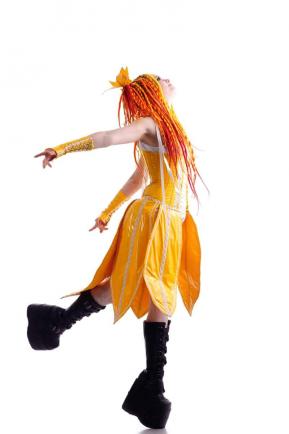
I stood on the sidelines of our small town football game on a crisp night when my 15-year-old daughter flounced into view with a group of her friends. Hands on her hips, chin in the air she asked me, "Mom, can I dye my hair green?"
"Why yes honey," I replied. "You can look as stupid as you want to."
"See! I told you so," she said to her friends and off they went. She never dyed her hair green. She just needed to know that she could.
I knew at that moment that she was doing important work for a teenager. She wasn't just talking about dying her hair green. So what work was my daughter doing? The same work your teen is doing when every day she changes her clothes 50 different times and then while standing on top of a 20 foot pile of clean and dirty clothes announces that she has nothing to wear.
My daughter was trying to figure out just who she was. She was trying on different identities free from as much parental influence as she could. She was showing her friends that she had control over who she was and what she chose to look like and even become.
For the first years of a child's life he has many identities. Your child develops them in an effort to survive, to please you, and other adults in his world, and to fit in with friends.
When children become adolescents they go through a period of time where they need to become independent of their parents and become their own unique person. They explore different identities as they try to figure out who they are. If they are successful and do a great job, they will find an identity they are happy with, pleases the people they are in relationships with and serves them in the future.
Child development expert Erik Erikson theorized that teens age 13 to their early 20s engage in establishing their own unique identity. When looking at teens finding identity he believed:
"This turning point in human development seems to be the reconciliation between 'the person one has come to be' and 'the person society expects one to become.' This emerging sense of self will be established by 'forging' past experiences with anticipations of the future."
How do teens figure out who they are? They try on different personalities, styles, lifestyles and a mountain load of ugly clothing and make up.
If we have too tight a grip on our teens, and we do not allow them to try on those wild and crazy outfits, they may feel the need to rebel. The tighter our grip, the more our child might push away and the more extreme the outfits may become. Or even worse, she may conform to our wishes and not explore who she is and who she could become.
Part of Erikson's theory includes the idea that when we don't establish our identity as a teen we do it later. Have you ever known an adult who seems to suddenly begin acting like a teenager? Perhaps it is better to let our teens work out those wardrobe changes before their 40th birthday.
So what can you do when your teen wants to go to school in plaid skinny jeans with a stripped top, colored hair and neon high top tennis shoes? Here are some ideas:
Remember clothing is temporary as is hair dye
Be grateful your teens are only trying on clothing that you don't like or hair styles that annoy you and that they haven't done anything that can't be undone like self-injury or body marking.
Choose your battles
Know where your absolute boundaries are. In my case, that was at tattoos and elective plastic surgery. In your case, modesty might be a priority. Communicate clearly and with love. Tell your teens your boundaries and priorities. Allow your teen to do normal exploration of identity within safe guidelines. Be ready to answer the question, "Why?"
Educate
When one of my children wanted to pierce her nose, I made sure she was involved in a conversation with an adult who was not happy with the constant infection the nose piercing had caused. When another one of my children was interested in ear gauging, I talked about the plastic surgeon that was making a lot of money fixing gauged ears. We talked about how it impairs employment and what jobs she was interested in.
Keep the focus on the future
Your child is trying to figure out who he or she is. Give her all the help you can. If she is interested in being the next Lindsay Stirling rock violinist take her to a concert. Talk about how she dresses and looks. If your child is interested in being an aeronautical engineer and building airplanes expose her to engineers. Talk about how they look when they apply for jobs and on the job.
Love them
Appearances are often indicators of inner pain. Sometimes dirty clothes, body odor and graphic T-shirts are telling you something. Your child might not feel safe. Body odor and violence is like wearing a personal castle to keep people out. It might be time to get professional help.
Keep your teens excited about the future and new and exciting things in store for them as they develop their identities and personalities. Be patient with them as they seem to be 2-year-olds again - wearing mismatched clothes that may be inside out. They are hard at work becoming grown-ups.

